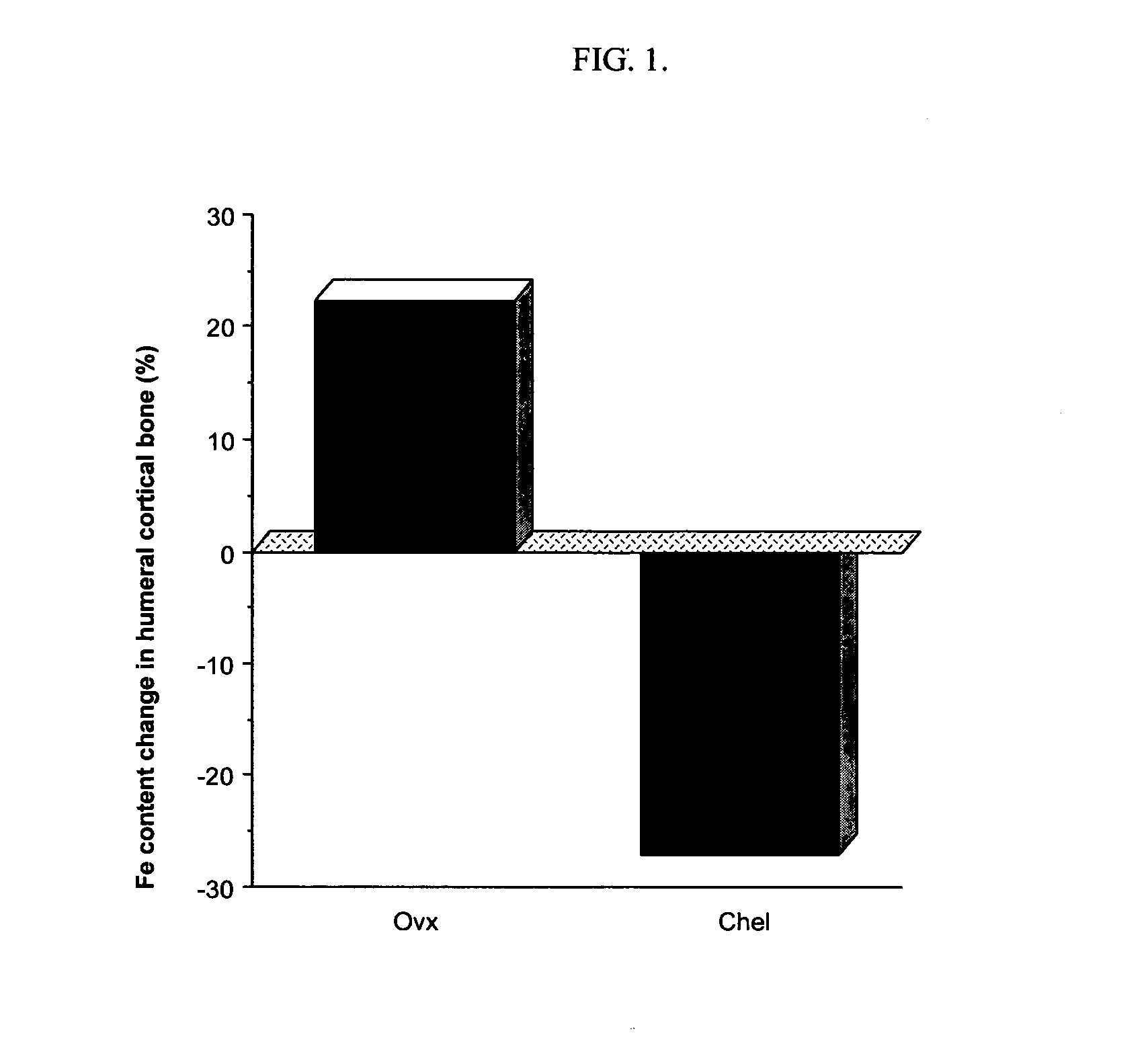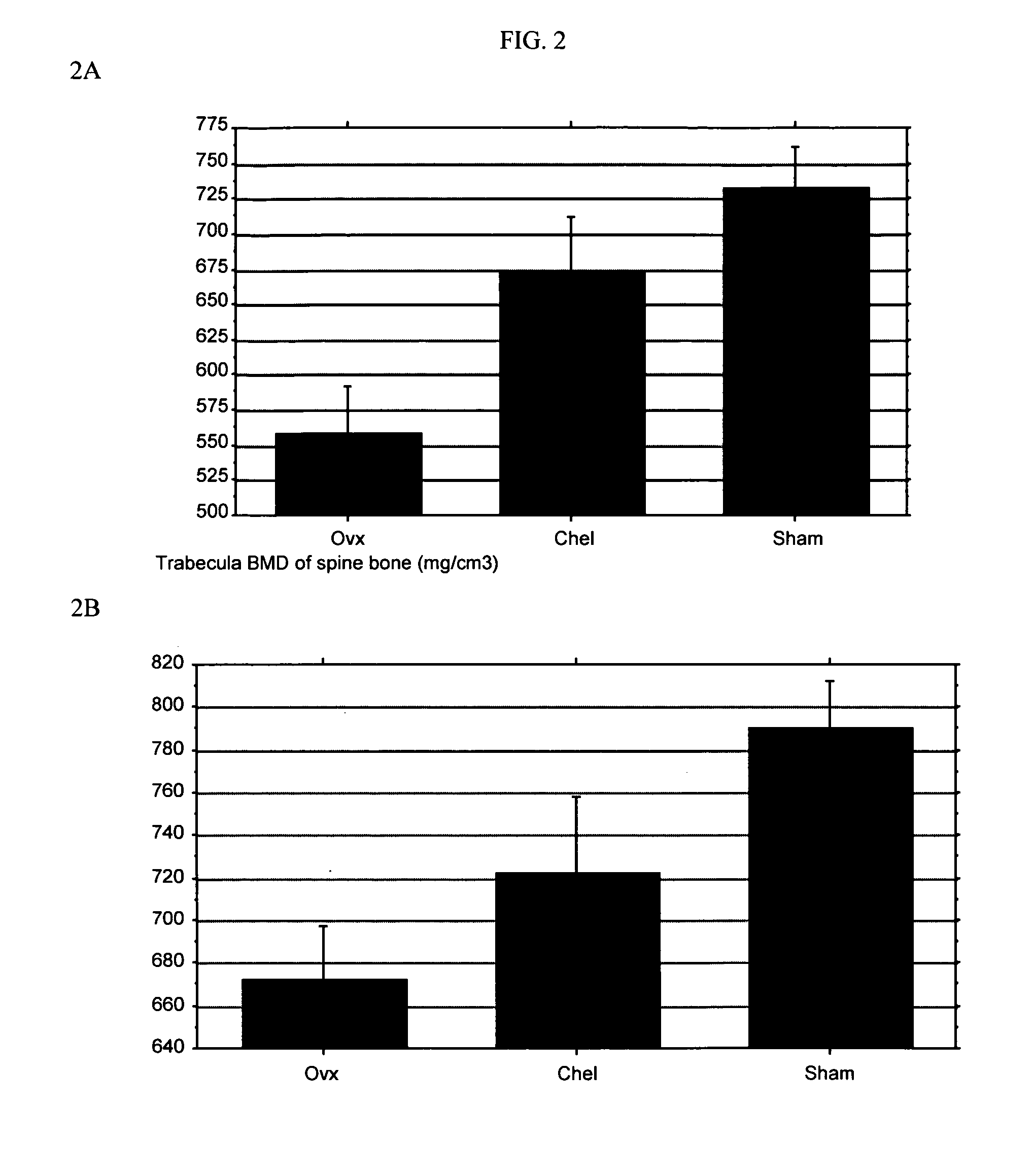Compositions and methods for chelation therapy
a chelation therapy and composition technology, applied in the field of biotechnology, can solve the problems of cellular dysfunction, increased risk of fracture, and long-held belief of free radical damage as a risk factor, and achieve the effect of reducing oxidative damage and increasing bone formation ra
- Summary
- Abstract
- Description
- Claims
- Application Information
AI Technical Summary
Benefits of technology
Problems solved by technology
Method used
Image
Examples
example i
[0076] Iron accumulation in osteoporotic bone of postmenopausal women was measured by EPR spectroscopy of femoral cortical bones from aged women, using Inductively Coupled Plasma Optical Emission Spectroscopy (ICP-OES). Three osteoporotic bone samples, each from three postmenopausal women, were examined. Three additional bone samples from three postmenopausal women without osteoporosis were also examined as age-matched controls. It was found that the total iron content in the bone of postmenopausal women with osteoporosis, with a mean value of 25.8 ppm±5.6 (standard deviation), are significantly higher (Paired t test, P<0.01) than that of postmenopausal women without osteoporosis (6.5 ppm±2.3). This observation further demonstrates the association of increased iron content in osteopathic bone of postmenopausal women and is consistent with the demonstration of increased free iron, assessed by EPR, in the osteopathic bone of postmenopausal women.
[0077] In postmenopausal women the lev...
example ii
[0078] EPR techniques were used to detect free iron and LLOFR, as a marker of oxidative damage. This approach has been used by others to assess similar events in soft tissues. Briefly, the iron signal, a broad component (BC) of the EPR native signal of bone (FIG. 3) was identified by comparison of the signal generated by reacting an organic entity which is commonly found in biological tissues with iron (FIG. 4). The original EPR signal of iron (BC) disappears upon treatment (FIG. 3) of bone granules with sodium nitrite that reacted with free iron to form specific iron-nitric oxide complexes. Furthermore, the narrow component (NC) (FIG. 3) is responsible for the LLOFR that is oxidized organic compounds and stable in some solid matrix, such as bone, seeds and plants. The NC is indeed identical with the EPR signal of stable organic free radical produced by morin hydrate due to oxidation (FIG. 4).
[0079] To demonstrate the reverse effect, the reaction of ferrous sulfate with morin hydra...
example iii
[0086] Histomorphometric analysis is performed on bone samples, for example, bone samples from Examples I and II may be used. Histomorphometric analysis provides information on bone structure, bone turnover and bone remodeling affected by increased iron, free radical damage and the effects of chelation therapy. Histomorphometric analysis is particularly valuable in analyzing the cellular pathophysiology of different forms of osteoporosis and in determining the mechanisms by which drugs affect bone.
[0087] This analysis is found to support the role of oxidative damage in the skeletal system. Thus, chelation therapy is found to provide a method to protect against postmenopausal osteoporosis and / or diseases associated with increased metals, such as iron, and free radical damage. For example, diseases associated with increased metals include, but are not limited to, senile and aging osteopenia in both men and women, as well as, neurodegenerative and heart diseases related to sex-hormone...
PUM
| Property | Measurement | Unit |
|---|---|---|
| concentrations | aaaaa | aaaaa |
| concentrations | aaaaa | aaaaa |
| concentration | aaaaa | aaaaa |
Abstract
Description
Claims
Application Information
 Login to View More
Login to View More - R&D
- Intellectual Property
- Life Sciences
- Materials
- Tech Scout
- Unparalleled Data Quality
- Higher Quality Content
- 60% Fewer Hallucinations
Browse by: Latest US Patents, China's latest patents, Technical Efficacy Thesaurus, Application Domain, Technology Topic, Popular Technical Reports.
© 2025 PatSnap. All rights reserved.Legal|Privacy policy|Modern Slavery Act Transparency Statement|Sitemap|About US| Contact US: help@patsnap.com



